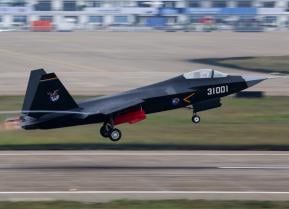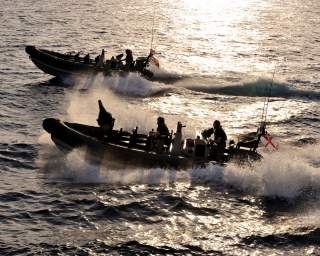Royal Marines and Japan’s Amphibious Force: A Match Made in Heaven?
Any why China should take notice.
In late August, the Japan Ground Self Defense Force (GSDF) put on its annual Fuji Firepower Demonstration at a training area near Mt. Fuji. It’s a choreographed display of GSDF weaponry with lots of shooting and explosions and draws thousands of spectators. But there’s a Potemkin aspect to it all, suggesting a more capable JSDF than exists.
However, a few days earlier and not far away at a smaller training site on the beach at Numazu, something more critical for the GSDF (and JSDF) almost happened.
Troops from Britain’s Royal Marines and the GSDF’s newly activated amphibious brigade (ARDB) were primed to conduct a joint landing exercise—coming ashore from the HMS Albion and the Japanese Navy’s JS Shimokita. Unfortunately, the exercise was canceled owing to a passing typhoon—though all preparatory work was done.
This near-miss at Numazu was significant—it was the first time foreign ground troops, other than Americans, were to train in Japan. And there was no public or political opposition, to the extent anyone even noticed. Prime Minister Abe has had some success pulling Japan's defense ‘back to the center' and changing public thinking.
A joint landing with British forces and a combined GSDF/MSDF amphibious team was unthinkable not many years ago—even if the planned landing exercise was a modest affair involving a small number of troops landing in rubber boats and a landing craft, with a Japanese Navy LCAC (hovercraft) making an appearance.
The HMS Albion’s visit to Japan (along with a 120-man company sized Royal Marine detachment) was part of a 10-month cruise out and back from the United Kingdom. The JSDF has worked closely with the U.S. Marines and U.S. Navy to develop its amphibious force, so the British infused some ‘fresh blood’—as they have a somewhat different approach to amphibious operations than the Americans.
The Numazu exercise and the HMS Albion’s presence at the U.S. Navy Base in Yokosuka and an ‘open house’ in Tokyo harbor also highlighted several challenges facing the JSDF’s amphibious development effort that still has a ways to go.
First, Japanese ships used for amphibious operations are not built to handle GSDF ground troops and their hardware and need to be jury-rigged to accommodate them. However, HMS Albion was purpose-built for amphibious operations—and with the Royal Marines in mind.
Indeed, the HMS Albion’s design offers Japanese shipbuilders a good blueprint for ships that maximize efficient command and control of ground, sea, and air operations as needed for amphibious operations—while also allowing easy movement of heavily laden Royal Marines and their equipment off, on and around the ship.
Next, while the Numazu training area is better than nothing, JSDF needs a ‘full-service' amphibious training area in Japan. Numazu is too small for training once ashore, and beach conditions are not ideal for moving equipment.
Improving amphibious skills requires constant practice. The ARDB and MSDF ships can’t make the lengthy, expensive trip often enough to Southern California, Hawaii, or Australia where better training areas are located. And U.S. facilities on Guam and in the Northern Marianas are still years from completion.
But Japan has 18,000 miles of coastline and many potential amphibious training sites. The central government just has to choose a place, figure the price local residents will demand and then pay for it.
Another longstanding obstacle to ARBD (and JSDF) improvement is excessive safety restrictions during training. Sea conditions genuinely were unsafe at Numazu and warranted canceling the exercise. But many military observers comment on Japanese ‘risk aversion’ when it comes to training. An oft-mentioned example is a prohibition on GSDF attack helicopters firing while moving—and shooting only while hovering. Do that and combat will be a short experience.
Finally, amphibious work—involving air, sea, and ground operations—is complex and almost nothing goes exactly as planned, including the weather. This is a problem because JSDF officers often seem reluctant to change ‘the plan’ without calling back to headquarters for permission.
The Royal Marines and Royal Navy, however, personify the concept of ‘mission orders’ and letting the forces ‘get on with it’ using their initiative. The JSDF can learn from this example.
One hopes ARBD becomes the place where officers and troops that want the freedom to use their initiative and imagination want to be assigned.
The start of an ARDB—Royal Marine friendship?
One hopes the Royal Marines and the ARDB will see more of each other.
Indeed, American advisors have suggested the JSDF study the highly professional British Marines (and their close relationship with the Royal Navy which in some respects is tighter and better than the USMC/USN relationship), rather than aiming at being a Japanese version of the U.S. Marine Corps.
The Royal Marines' small size (only 6,000 men), equipment, organization, and operational techniques differ from the Americans, and some aspects are well suited for the ARDB.
Unfortunately, the HMS Albion is the British Navy’s only amphibious ship, so it may not return to Japan for some time. In a ‘pound foolish’ move, the Her Majesty’s Government recently sold its other amphibious ship, HMS Ocean, to the Brazilian Navy.
But it’s still easy to bring the Royal Marines out to Japan or nearby to train with the Japanese ‘Marines’ and MSDF—making use of the Japanese Navy’s seven amphibious ships—and also join with the Americans and other friendly forces.
Something like this already happened in 2017, when Royal Marines and French Marines aboard the French amphibious ship Mistral trained on Guam and nearby Tinian in a four-way exercise with U.S. Marines and the Japan Ground Self Defense Force.
Even better, the United Kingdom might assign a Royal Marine officer to Japan to work with the GSDF and MSDF. And vice versa. ARBD officers will particularly benefit from assignments with the Royal Marines in the United Kingdom or afloat.
Moreover, the GSDF may procure its own transports and possibly landing craft. This means the British Marines might help ARDB build a version of the Royal Marine Assault Squadron—‘sea specialists' permanently embarked on Navy ships which serve as Landing Craft Coxswains and the like.
In addition, the MSDF’s ‘helicopter destroyer’ JS Kaga (an amphibious ship in all but name) recently set off on a show-the-flag cruise to Southeast Asia and the Indian Ocean. However, it appears to have neglected to embark ARBD ‘Marines’ and thus squandered a valuable opportunity to build the GSDF-MSDF amphibious relationship. Tokyo should get it right next time by taking the Japanese ‘Marines’ along and linking up with Royal Marines somewhere along the way.
Britain reportedly plans to have a Royal Navy ship operating in the Asia-Pacific region for the foreseeable future. This has its uses as ‘marker' demonstrating London's looks askance at Beijing's efforts to dominate East Asia. But one ship is still just one ship in a vast region.
So, use the Royal Marines to augment this effort, and in the process, they can also help improve local amphibious forces, such as Japan's, that all need improvement in different areas.
The Fuji Firepower Demonstration is admittedly a lot of fun to watch. But rather than showing off at Mt. Fuji, more and better amphibious training—and with partners like the British—is a better way to spend JSDF’s limited time and money.
Grant Newsham is a retired U.S. Marine Officer and is a Senior Research Fellow at the Japan Forum for Strategic Studies.
Image: Wikimedia


